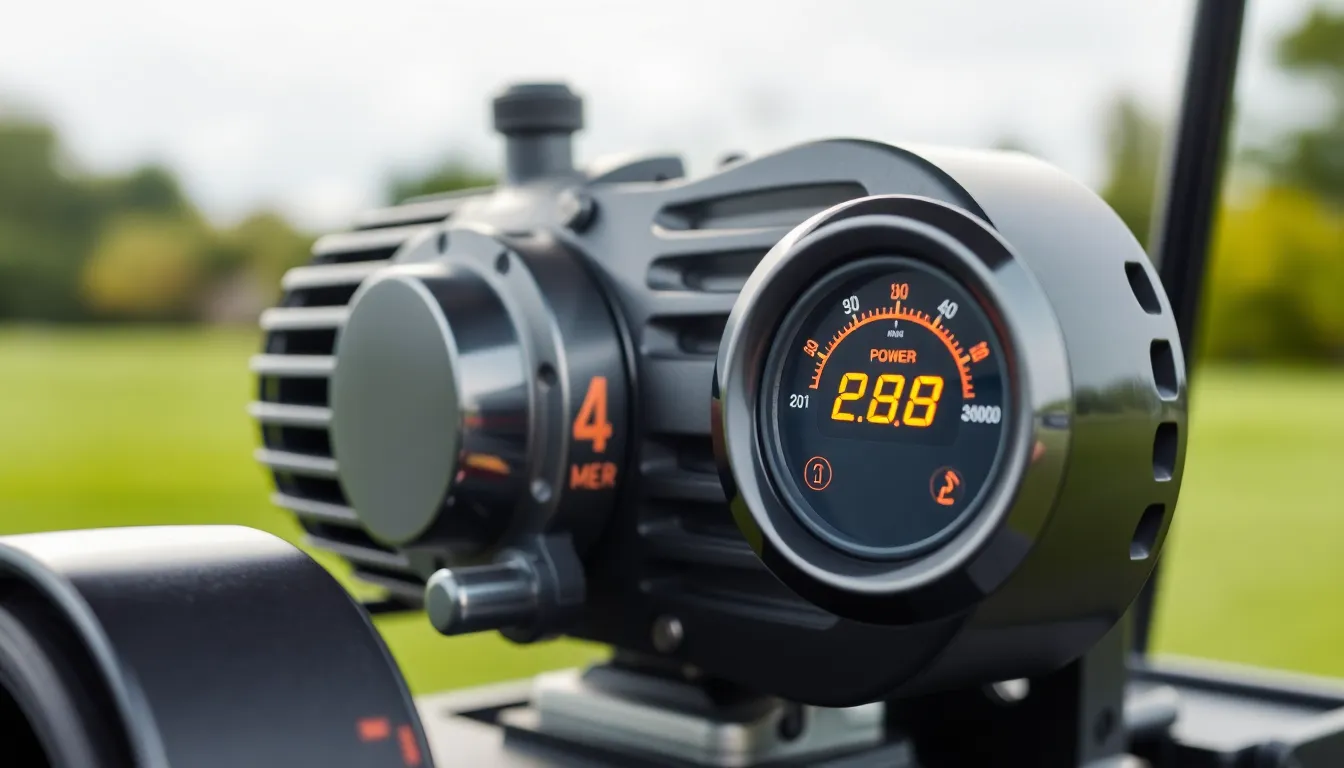
How Much Is a Golf Cart? Complete Pricing Guide 2025
Discover how much a golf cart costs in 2025 with our comprehensive pricing guide covering new, used, electric, and gas models plus ownership expenses.
Learn what is the draw on golf cart motor, how to measure amperage, and ways to optimize your battery life with our comprehensive power consumption guide.

Understanding the power consumption of your golf cart motor is essential for maintaining performance and extending battery life. The "draw" on a golf cart motor refers to the amount of electrical current (measured in amperes or amps) that the motor pulls from the batteries during operation. This power consumption varies based on several factors including terrain, load weight, and the condition of your cart.
The electrical current drawn by your golf cart motor is a key factor in how your cart performs and how long your batteries last. Let's break down what this means and why it matters.
Amperage draw refers to the amount of electrical current that flows from your batteries to your motor when the cart is in operation. Think of it like water flowing through a pipe:
According to research by the Electric Drive Transportation Association, understanding your golf cart's power consumption can increase battery life by up to 30%.
Golf cart motor amperage draw varies significantly depending on operating conditions:
During Normal Operation (flat terrain, moderate speed):
During Heavy Load Conditions (uphill, carrying passengers):
When Starting From a Stop:
Measuring the amperage draw of your golf cart motor is relatively straightforward with the right tools. This information can help you diagnose problems and understand your cart's power consumption.
For a detailed guide on other aspects of golf cart maintenance, check our article on golf cart repair and maintenance.
When interpreting your golf cart motor's amperage draw readings, keep these reference points in mind:
Above 400 amps or continuous high draw
If you're interested in maximizing your golf cart's speed and performance while managing amperage draw, read our guide on how fast can a golf cart go.
Understanding what influences your golf cart's motor draw can help you optimize performance and extend battery life. Here are the key factors that impact how much current your motor pulls:
The physical characteristics of your motor have a significant impact on its power consumption:
A study by the National Renewable Energy Laboratory found that upgrading to a high-efficiency motor can reduce amperage draw by 15-25% under typical operating conditions.
The environment you're driving in dramatically affects amperage draw:
The total weight your golf cart carries directly impacts how hard the motor works:
To understand how weight impacts other aspects of golf cart operation, see our guide on golf cart weight and carrying capacity.
Recognizing when your golf cart motor is drawing too much current can help prevent damage to your electrical system and extend battery life. Here are common indicators of excessive amperage draw:
According to the Golf Cart Association of America, addressing abnormal amperage draw promptly can prevent up to 80% of major motor failures and electrical system damage.
One of the most significant consequences of excessive motor draw is its effect on your battery system. Understanding this relationship can help you maximize battery lifespan and performance.
The rate at which your motor draws current directly affects how quickly your batteries will be depleted:
For more detailed information on golf cart batteries and their costs, see our article on golf cart battery replacement costs.
Excessive amperage draw not only depletes your batteries faster but can also shorten their overall lifespan:
Optimizing your golf cart's electrical efficiency can significantly improve battery life and performance. Here are practical ways to reduce the amperage draw on your motor:
Keep motor brushes, bearings, and commutator clean and in good condition. A well-maintained motor draws less current.
Maintain proper tire pressure. Under-inflated tires increase rolling resistance and motor workload.
Lubricate moving parts regularly and ensure wheels spin freely without drag.
Remove unnecessary weight and accessories when not needed to reduce the base power demand.
Ensure proper wheel alignment and axle straightness. Misalignment creates drag and increases amperage requirements.
Regularly clean battery terminals and electrical connections. Corrosion increases resistance and forces the motor to draw more current.
Upgrade to a High-Efficiency Motor: Modern motors can provide the same power with lower current draw.
Install a Programmable Controller: Allows fine-tuning of acceleration rates and current limits.
Upgrade Wiring: Thicker gauge wiring reduces resistance and improves efficiency.
Voltage Upgrades: Converting from a 36V to a 48V system can reduce amperage requirements for the same power output.
The American Society of Golf Cart Engineers recommends that routine electrical system maintenance can reduce average amperage draw by up to 20%.
Your driving style significantly impacts how much current your motor draws:
If you're considering whether a golf cart meets your specific needs, our guide on do you need a license to drive a golf cart provides valuable information on operational requirements.
Not all golf cart motors are created equal. Understanding the differences between motor types can help you choose the right one for your needs and manage power consumption effectively.
Typical Idle Draw: 1-2 amps
Cruising Draw: 20-35 amps
Peak Draw: 300-400 amps
Pros: High torque at low speeds, simple design
Cons: Higher current draw at cruising speeds
Typical Idle Draw: 0.5-1 amps
Cruising Draw: 15-25 amps
Peak Draw: 250-350 amps
Pros: More efficient, regenerative braking
Cons: Higher initial cost, more complex controller
Typical Idle Draw: 0.5-1.5 amps
Cruising Draw: 18-28 amps
Peak Draw: 275-375 amps
Pros: Better efficiency than standard DC, moderate cost
Cons: Still less efficient than AC at higher speeds
For more information on golf cart pricing that includes different motor options, see our article on how much is a golf cart.
A normal amp draw for a golf cart motor ranges from 15-30 amps during flat terrain cruising. At idle with the key on, draw should be under 2 amps. During acceleration or climbing hills, draw can temporarily increase to 50-300 amps, depending on the steepness and load. Consistent readings above these ranges may indicate a problem with your motor or electrical system.
High motor draw significantly impacts battery life. Excessive amperage draw generates heat within batteries, accelerates plate deterioration, and increases sulfation. Regularly operating your golf cart under high-draw conditions (like constant hill climbing or overloading) can reduce battery lifespan from the typical 4-6 years down to 1-3 years. Managing motor draw through proper maintenance and driving habits is essential for maximizing battery longevity.
Excessive amp draw can be caused by several factors: worn motor brushes or bearings, binding in the drivetrain, underinflated tires, excessive weight, electrical shorts, a failing controller, solenoid problems, or battery issues. Regular maintenance can prevent many of these problems. If you notice sudden increases in amperage draw, have your cart inspected by a qualified technician to identify and address the specific cause.
DC motors typically draw more amps than AC motors, especially at cruising speeds. While DC motors provide excellent torque for starting and climbing, they're less efficient at sustained speeds. AC motors generally draw 10-20% less current during normal operation, though their peak draw during acceleration can be similar. The efficiency advantage of AC motors becomes more significant over longer distances and at higher speeds, making them increasingly popular in newer golf cart models.
To reduce amperage draw: ensure proper tire inflation, maintain clean and lubricated moving parts, reduce unnecessary weight, keep electrical connections clean and tight, adjust driving habits (smooth acceleration, maintain steady speeds), consider upgrading to high-efficiency motors or controllers, and perform regular maintenance on your motor and electrical system. These steps can collectively reduce amperage draw by 15-30%, significantly improving range and battery life.
The amperage draw of your golf cart motor is a critical factor that affects performance, range, and long-term reliability. By understanding what constitutes normal draw, recognizing signs of excessive consumption, and implementing strategies to optimize efficiency, you can significantly extend your cart's range and battery life.
Regular monitoring of your golf cart's amperage draw serves as an early warning system for potential mechanical or electrical issues. When combined with proper maintenance and thoughtful operation, managing your cart's power consumption will help ensure years of reliable service and minimize the need for costly repairs.
Whether you're a golf course operator managing a fleet or a private owner enjoying weekend rides, keeping your golf cart's motor draw within optimal ranges will provide the best balance of performance and longevity for your investment.

Discover how much a golf cart costs in 2025 with our comprehensive pricing guide covering new, used, electric, and gas models plus ownership expenses.

Discover if you need a license to drive a golf cart with our comprehensive guide to state laws, age requirements, and legal regulations for golf cart drivers.

Discover the best golf push cart options of 2025 with our comprehensive guide comparing features, prices, and durability for every type of golfer.
Get the latest updates on golf cart services, tips, and exclusive offers delivered to your inbox.